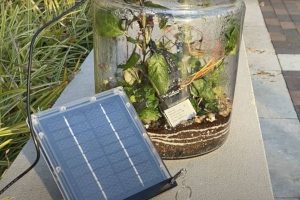Metal-organic ferrocenes could make perovskite solar cells more stable, according to Imperial College in London. The cells in question are a joint venture between Imperial and City University of Hong Kong (CityU). “Our collaboration with was beautifully serendipitous, arising after I gave a talk about new ferrocene compounds and met Zonglong Zhu from CityU, who asked me to send over some ...
Research
The latest electronics research news from within the industry and universities from around the world.
Thermo-electric generator is 40% efficient, but only at 1,900-2,400°C
MIT has created a thermovoltaic demonstrator that can convert heat energy at between 1,900 and 2,400°C in to electricity energy with 40% efficiency – which is above that of a steam turbine. The technology is aimed at future grid-scale energy stores. Analagous to a multi-junction photovoltaic cell, MIT’s device has two stacked junctions, each picking up part of the incident ...
What needs to be done to make useful Li-CO2 batteries?
Lithium-carbon dioxide batteries have theoretical promise, including in aviation where the lightweight materials are desirable – it might might make good use of Mars’ 96% CO2 atmosphere, for example. Headline figures are a theoretical specific energy density of 1,876Wh/kg and a ~2.8V discharge potential, but in practical terms the technology has not even reached infancy. To build a solid foundation for its development, a ...
Robotic finger tip makes human-like ‘nerve’ signals
Researches at the University of Bristol have created an artificial fingertip that produces signals that appear to mimic human touch nerve signal. “We found our 3D-printed tactile fingertip can produce artificial nerve signals that look like recordings from real, tactile neurons,” according to Bristol’s professor of robotics Nathan Lepora. “Human tactile nerves transmit signals from various mechanoreceptors, which can signal ...
Synopsys and Juniper Networks form new player in silicon photonics market
There will be a new player in the dynamic silicon photonics sector, as Synopsys and Juniper Networks announce a partnership to form a new, separate company, with Synopsys as the majority owner. As yet, unnamed, the company will offer an open silicon photonics platform (integrated lasers, optical amplifiers) and photonic components. The companies believe that this platform will lower the ...
Micro:bit rides through brown-outs to teach energy harvesting
To teach children about programming processors that are powered by energy harvesting, Northwestern University engineers have made the Micro:bit educational computer power-aware and self-backup-ing. Three things are required: a modified version of Microsoft’s drag-and-drop MakeCode programming environment, an energy harvester such as a solar panel, and an SPI FRAM chip – the team is using Adafruit’s ‘SPI non-volatile FRAM breakout’ board. The Northwestern ...
Single crystal graphene grown on sapphire
Researchers in Saudi Arabia have grown wafer-scale single crystal graphene on insulating substrates. “If graphene can be grown on an insulating substrate with a clean interface, certain devices might function better,” said project scientist Bo Tian of KAUST – the King Abdullah University of Science and Technology. “This also opens the door to new types of graphene-based nanodevices.” The technique ...
Some neural networks will always be unreliable
Some neural networks can exist, but cannot be trained to be reliable, according to mathematicians at the Universities of Cambridge and Oslo. “The paradox identified by Turing and Gödel has now been brought forward into the world of AI” Matthew Colbrook (right) “Many AI systems are unstable, and it’s becoming a major liability, especially as they are increasingly used in high-risk ...
Large sky blue perovskite LED, perhaps for lighting
Large-area sky-blue perovskite LEDs have been created at the University of Science and Technology of China (USTC) of the Chinese Academy of Sciences. The precursor, a CsPb(Br0.84Cl0.16)3 solution using a custom solvent blend, was blade-coating onto a substrate where the substance crystallised into grains – halide amine additives controlled he growth of perovskite grains and passivate the traps. “They partially replaced dimethyl ...
ADI invests €100m in Limerick
Analog Devices is to invest €100 million in a Europen research centre in Limerick, over three years. ADI Catalyst will be a 100,000ft2 custom-build its campus on the Raheen Business Park in Limerick. “ADI Catalyst is a state-of-the-art collaboration accelerator where ecosystems of customers, business partners and suppliers engage with ADI,” according to the company. “This latest phase of expansion will ...
 Electronics Weekly Electronics Design & Components Tech News
Electronics Weekly Electronics Design & Components Tech News








